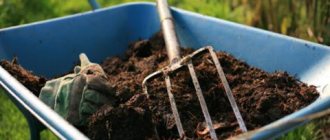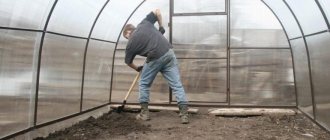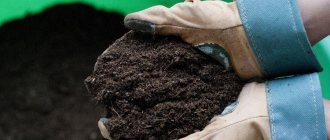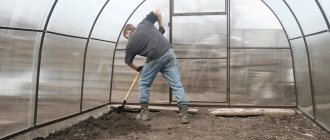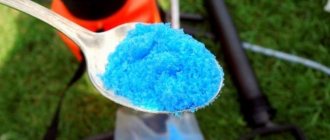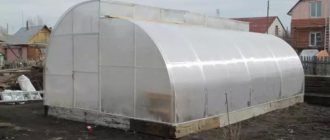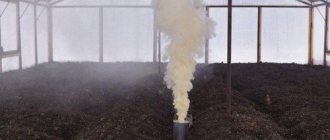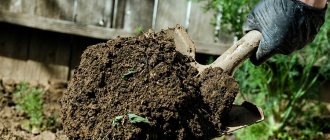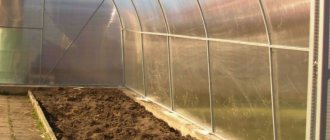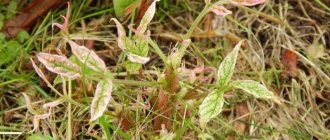Processing a greenhouse in the fall is an important process on which the yield in the coming season depends. Some gardeners limit themselves to digging and removing plant debris. As a result, it leads to seedlings being damaged by diseases and pests.
Autumn treatment of the greenhouse includes washing the structure, cleaning and infection control. After harvesting, it is important to prepare the land for spring planting. After reading the article to the end, you will learn in what sequence you need to act, how and with what to destroy insects, water the soil, and spray the walls.
Why treat a greenhouse in the fall?
The greenhouse and the soil in it after harvesting can be infected with pathogenic microorganisms, fungi and various pests. All sorts of preventive measures will help get rid of them.
Experienced vegetable growers know that fungus, mold, and insect larvae that have overwintered in a greenhouse will be difficult to attack new seedlings in the spring and will be difficult to fight. For example, a whitefly can be destroyed when it is in the larval stage, since the adult is not afraid of even strong chemicals.
Therefore, it is better to disinfect the greenhouse and soil in the fall than to lose the future harvest due to pest attacks.
Cleaning the greenhouse in the fall
The autumn period is just right for thoroughly cleaning the greenhouse after harvesting. First you need to put the beds in order, clearing the soil of roots, mulch and plant debris.
It is especially important to remove remnants of tomato tops, which can infect future plants with late blight. Plant residues should not be put into compost; it is better to burn them, destroying bacteria and pests.
What cleaning work is carried out:
- Removing outside all the parts that served as support, pegs, garters.
- Pulling out gardening tools, winding up watering hoses.
- Collection and subsequent burning of tops, garbage, and uncollected rotten fruits.
- Detection and collection of insect larvae that appear on the soil surface.
- Digging up the soil, pulling out small roots and parasite larvae from it.
- Cleaning paths. If the paths are lined with tiles or other material, then they must first be swept and then sprayed with a hose with strong pressure.
Cleaning beds from mulch and plant debris
For the winter, all foreign debris that has accumulated over the season is removed from the greenhouse:
- Mulch, weeds, dried flowers and shoots, cuttings of dressing material;
- Tops and fallen leaves, wormy and rotten fruits infected with diseases are raked from the beds;
- When cleaning the greenhouse in the fall and preparing it for the winter, yellowed bushes of tomatoes, cucumbers, eggplants or peppers are carefully dug out along with the rhizome. Phytophthora spores and other dangerous pathogens settle on the roots and are not afraid of frost, so they cannot be left in the ground.
Paths lined with brick or pieces of roofing felt are swept and watered with a hose, and weeds sticking out of crevices are cut out with a flat cutter.
Important! Dry and diseased plants are burned outside the site to ensure that germs do not spread to neighboring beds.
Tilling the soil in a greenhouse in autumn
After cleaning the greenhouse, you need to start cultivating the soil.
Soil replacement
In autumn, the soil in greenhouses is teeming with all types of microorganisms. The best treatment method is partial replacement of the soil.
By using fertilizers and insecticides in the summer, we unwittingly allow microorganisms to accumulate in the soil. In this regard, once every 2-3 years, 10-15 cm of the top layer of soil should be replaced with a new one. If you can replace 10 cm of soil with fresh, fertile soil, then this is an ideal option.
The removed soil can be placed in compost, scattered on beds, or spread under fruit trees.
After removing the old soil, it is advisable to bring in new soil and treat it with Fitosporin. We can’t leave it untreated, because we don’t know what pests live in it.
What to do if it is impossible to replace the soil?
In this case, you will have to prepare it yourself. There are several ways to cultivate soil in a greenhouse:
- Biological: the use of trichoderma green, which will destroy plant debris with pathogens located on them.
- Treatment with peracetic acid. For 1 liter of 9% vinegar, take 200 ml of 3% hydrogen peroxide. This mixture must be kept for 7-10 days in a dark place. One glass of this mixture per bucket of water is enough to treat the soil.
- Eradicating solution with iron sulfate. Add 1 tbsp to 10 liters of water. citric acid, 400-500 g of iron sulfate, 1 liter jar of urea. Stir, filter and thoroughly spray the soil surface before digging.
- At the same time, you can sow green manure. After the green manure has sprung up and grown properly, it must be sealed inside or mowed. It is recommended to dig up the soil in the greenhouse and turn the clod over.
In this video, popular video blogger and biologist Ivan Russkikh tells how to prepare peracetic acid for soil in a greenhouse and what advice it is better not to listen to.
Folk way
To disinfect the soil from pests, you can use the traditional method:
- Make a thick infusion of onion peels. It will rid the soil of blossom end rot fungi.
- Mix the soap solution with ash and pour it on the ground. This will rid it of powdery mildew, spotting, clubroot, and blackleg spores.
- A solution prepared from water and dry mustard will help get rid of many germs.
- Sprinkle dry bleach powder on the ground in an even thin layer, then dig it to a depth of 15-20 cm.
- Prepare hot water, spill the soil and cover it with film for a day. This event is held 3 times in the fall. It is effective against bacteria and pest eggs.
- You can also treat it with cold by opening the greenhouse for 5-6 days in frosty weather.
Winter care
Despite the fact that you have already mothballed the greenhouse structure, you will need to care for it in winter.
In some cases, for example, if you do not live on the site in winter, you can remove the polymer sheets. This work must be done with caution and only if your design allows it.
In winter, it will be necessary to clear the snow around the greenhouse and remove snowdrifts from the roof of the structure.
Improper preservation for the winter
Not knowing how to properly leave a carbonate greenhouse in place over the winter can have serious consequences for the design of your indoor vegetable garden.
If you do not want your greenhouse to be broken in the spring, then install stops from a vertical pole, one end of which should rest against the arc of the greenhouse, the other against the ground.
All additional elements: side windows, pistons will have to be removed for the winter for storage in a warm room, since at sub-zero temperatures the pistons can be damaged, see photos and videos.
If your indoor garden uses an automatic watering system, be sure to put it in a safe place.
Sometimes the vents on the roof of a greenhouse structure are built into the frame. We will have to install additional amplifiers for these vents (photo).
To successfully grow vegetables in your greenhouse, you must always open the doors throughout the winter so that the soil in the greenhouse freezes. This way you can get rid of all parasites. When cleaning the greenhouse structure, you need to avoid impacts and various types of mechanical impact. Only if you take good care of your greenhouse equipment will your indoor vegetable garden serve you for many years.
propolikarbonat.ru
Additional treatment of soil in a greenhouse against pests
Copper sulfate (100 g per bucket of water) is considered a universal disinfectant. This is also an excellent fertilizer, but it can only be applied once every 5 years, otherwise the acidity of the soil will increase. The soil can simply be sprayed with copper sulfate.
If you notice that the plants have been affected by powdery mildew, then fungicides will help get rid of this fungus:
- Topaz,
- Fitosporin,
- Quadris,
- Tiovit Jet,
- Gamair.
It is difficult to get rid of fusarium, but you can try to remove the fungus using the following means:
- Trichophyte,
- Gamair,
- Previkur Energy,
- Oksikhom.
If a spider mite has been noticed, then the soil must be treated with Bordeaux mixture, and then the entire room must be fumigated with smoke from a sulfur bomb.
Help to get rid of cladosporiosis or brown spot
- Pseudobacterin-2,
- Fitosporin,
- Polisher,
- Home.
Root rot mercilessly destroys plantings in a greenhouse. To remove it, you need to treat the soil with biological products.
- Baktofit,
- Gamair,
- Pseudobacterin-2,
- Planriz,
- Trichodermin.
There is no need to fear that the chemicals will damage the soil and destroy any future plant. If the treatment is carried out in the fall, then by spring everything will disappear and will not affect the harvest in any way.
Winter care
Stationary factory-made greenhouses, made of high-quality cellular polycarbonate , do not require special care in winter. You just need to follow the basic rules:
— keep the coating clean - the absence of contamination of the outer surface greatly facilitates snow removal; — clear snow accumulated around the greenhouse if its height becomes more than 0.5 meters; — remove a layer of snow 10 cm thick or more that has accumulated on the roof; To do this, simply tap your hand on the polycarbonate, going from the inside.
It is useful to pour a not too thick layer of snow inside the greenhouse - it will protect the ground from freezing, and in the spring it will melt and moisten it.
Take spring snow into any large container; it contains a large amount of useful fertilizers. Water with melt water at the beginning of germination - the plants will bear fruit earlier and suffer less pain.
Disinfection of greenhouse walls and structures in the fall
Now you can begin preparing the walls of the greenhouse. It is recommended to treat the walls in the greenhouse after the first soil preparation.
Disinfection of a polycarbonate greenhouse in the fall is one of the most important activities. Cucumbers, peppers and tomatoes are most often grown in a greenhouse, which can suffer from various diseases in greenhouse conditions. There are a lot of means to get rid of pathogenic microflora.
Many summer residents disinfect the entire greenhouse with a solution of potassium permanganate. Potassium permanganate can kill many parasites.
How else can you disinfect a greenhouse in the fall? Soda, formaldehyde (250 g per bucket of water), and 5% copper sulfate will cope with this task.
Watch this video in which Ivan Russkikh tells how to treat a greenhouse in the fall after finishing the tomato, pepper and cucumber crops. There is one inexpensive remedy available to everyone, which has proven to be the most effective for disinfecting a greenhouse from diseases.
Ivan Russkikh is a popular video blogger, expert of the Youtube channel “Procvetok” and the channel “Ivanova Science”. Researcher, teacher, head of the Research Laboratory of the Russian Center for Economics and Culture, member of international scientific communities.
The best solution for sanitizing walls is a white solution (hypochlorite). Prepare a solution: pour 1 liter of chlorine bleach White (the composition should contain sodium hypochlorite 25-30%) into 10 liters of water.
Within an hour after preparing the solution, spray the greenhouse with a sprayer. After a week, you can rinse the greenhouse with a sprayer with clean water.
You can also use chlorine-free peroxide bleaches, for example, Bos, Persol, Vanish, which contain perborates. We dilute the bleach as indicated in the instructions for bleaching laundry. The water should be hot, at least 60-70 degrees. We treat all surfaces of the greenhouse with a sprayer.
When using chemicals in a greenhouse, be sure to protect yourself from chemical fumes and splashes. Prepare protective items: respirators, aprons, goggles, rubber gloves. After treatment, immediately leave the greenhouse and wash yourself. And in the greenhouse itself, open the windows and doors to ventilate it.
When spring comes, your greenhouse will be clean, free of pests, mildew and mold. In addition, a clean, washed and treated structure will last longer.
Green manure plants
Green manures are unpretentious crops that are resistant to mechanical stress and cold. They disinfect and treat the soil.
Suitable for greenhouses:
- white mustard;
- Vika;
- rye;
- radish;
- alfalfa or phacelia.
While working in the greenhouse in the fall, after preparing it for winter, green manure grasses are sown. Green manure:
- increase air exchange;
- inhibit the growth of weeds;
- replenish the lack of humus;
- reduce acidity;
- prevent drying out of the soil and supply it with nitrogen.
Long taproots deeply penetrate the substrate and loosen it naturally much more effectively than walk-behind tractors. In addition, green manure crops protect seedlings from low temperatures, especially at night.
Sowing of green manure is carried out on the treated area in September-October.
Rotten roots form many channels that are saturated with moisture and oxygen. As a result, heavy and dense soil turns into more loose and cohesive soil.
Seeds are distributed along the perimeter of the structure in bulk or sown in furrows, covering the top with a rake. The bed with the embedded seeds is watered with a solution of Fitosporin. If sowing was carried out in early autumn, the seedlings are moistened daily for 15 days. You can also cover the green manure with compost so that the moisture evaporates more slowly.
In winter, grown plants are mowed to prevent the formation of hard stems. They are cut off at the root and left on the site, and in the spring they are used as mulch, liquid grass fertilizer or compost.
Larisa Zarubina from the Garden Guide, when preparing a greenhouse for the winter, warns novice gardeners that autumn sowing of green manure can only be done after treating the structure and soil, including the use of smoke bombs. Otherwise, the plants will die.
Washing the greenhouse and equipment in the fall
At the end of the summer season, all equipment, like the greenhouse itself, must be put in order and washed thoroughly. What to wash with? Take mops, brooms, rags.
Rinse the outside of the structure with water by pointing a hose at it.
If you were unable to disinfect with white, then the inside of the greenhouse wall can be washed with water and suds of laundry soap (1 piece per 10 liters of water) or dishwashing detergent. Apply the solution to dirty areas, and after 10 minutes, rinse with water. Rinse gardening tools in the same way.
What to do in the greenhouse in the fall with the frame structure? You need to pay close attention to these parts. Mold may appear at the joints, which will become a good breeding ground for fungi and bacteria.
These areas can also be washed with a concentrated solution of laundry soap. Laundry soap will well disinfect the joints of parts and everything that you wash.
You should not use a detergent with strong active ingredients, so as not to reduce the transparency of the greenhouse covering material.
Disinfection and washing of polycarbonate greenhouses in the fall with non-removable parts is carried out with a soap solution using brushes with long handles. After washing with soapy water, rinse off the soap with a hose.
If the polycarbonate has faded and even turned green in places, then you need to take 3 tablespoons of hot water per bucket. washing powder, ammonia, vinegar, a little bleach and mop the greenhouse. The greenhouse will become transparent.
The wooden frame should be treated with antiseptics, and for the metal frame it is necessary to prepare an anti-corrosion agent.
To disinfect all parts of the greenhouse, especially joints, you can use a solution of copper sulfate (100 g per bucket of water) or bleach (400 g per 10 liters of water).
A glass greenhouse can be washed with window cleaning liquid. It contains alcohol, which is also a disinfectant. Therefore, consider that glass disinfection has already been carried out. And the frames can be washed with a solution of laundry soap.
When should you wash a polycarbonate greenhouse in the fall? The best time is September, early October. These activities must be completed before stable frosts.
Preparing the greenhouse for winter
We have given different methods for treating the soil and walls of the greenhouse. All this will help create good conditions for the future harvest.
A Complete Guide to Winterizing Your Greenhouse
To put all the information in one place, watch this short video.
Preparing a greenhouse for tomatoes in the fall
In order to get a good harvest of tomatoes next year, in addition to disinfecting the soil, you should add fertilizers and lime to reduce the acidity level, and sow green manure.
When digging, it is useful to add ash, humus, manure, and compost. Tomatoes need potassium and nitrogen most of all.
In autumn, add to the soil:
- monophosphate – 40 g per 1 sq. m,
- double superphosphate – 20–30 g per 1 sq. m.
It will be useful to enrich the soil with preparations containing potassium, for example potassium magnesium.
How to clean?
Greenhouse structures that are actively used throughout the year become polluted both from the outside and from the inside. Dust settles on the walls, mold appears in corners and crevices, larvae, spider mites and fungi appear. Traces of atmospheric precipitation also remain on the surface.
A warm and nutritious environment creates a favorable microclimate for the development of fungal infections and pathogens. Therefore, it is necessary to thoroughly wash and disinfect the entire structure in order to protect the future harvest from unpleasant surprises.
Important! To protect against corrosion, damaged areas of the metal frame must be treated when caring for the greenhouse in the fall and preparing it for winter. They are brushed, primed with an anti-oxidation agent and painted.

